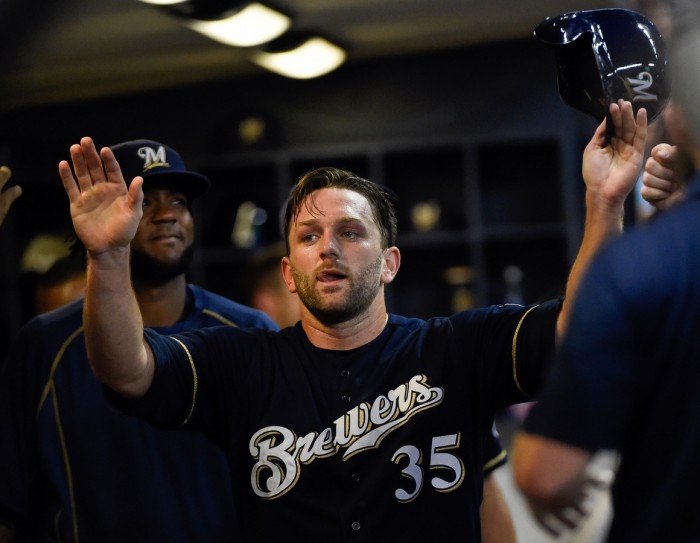The Brewers have had stability in center field since Carlos Gomez took over full time duties in 2012. He’s now in Houston. The top center-field prospects (Brett Phillips, Tyrone Taylor, Michael Reed) won’t be ready for regular playing time until mid/late-2016 at the earliest and possibly not until the beginning of the 2017 season. Thus, for right now and perhaps for all next season, the center field position is wide open.
Shane Peterson has begun to separate himself as the early in-house front runner. The only other options are Elian Herrera and Logan Schafer — neither of whom has performed well at the major-league level. In 158 plate appearances this season Peterson has hit .277/.342/.355 which equates to a .256 TAv (.260 is league average). While not great, it’s significantly better than what Schafer and Herrera can offer. The problem is that we’re dealing with a very small sample size, so it’s hard to know if we can expect him to continue producing similar numbers.
Peterson does do a few things that have me hopeful he can at least maintain, if not improve, that slash line. He has shown a strong ability to draw walks. This year at the major-league level, he has an 8.9 percent walk rate which is above the league average of 7.5 percent. Over his entire minor-league career he owns an 11.6 percent walk rate.
While his power numbers have disappeared upon his arrival with the Brewers, he fared better in the minors. He has a .427 slugging percentage over eight seasons in the minor leagues. That power manifested itself in doubles more so than in home runs. His career high in home runs is 12. However, last year he reached a career high of 40 doubles, and he has topped 20 doubles in several other seasons.
Although batted-ball data does not seemingly exist for the minor leagues, it should be noted that he currently has an above-average line-drive rate. His doubles power seems to match up with that. This gives some hope that he can maintain an above-average batting average on balls in play (BABIP). He currently has a .375 BABIP but league average is only .298. That .375 is probably unsustainable, and if that drops, so will the rest of his slash line. If he can maintain a strong walk rate and an above-average line-drive rate, it shouldn’t end up hurting him too much. If he can tap back into the modest power numbers he’s shown in the minors, he could start producing better overall despite a lower BABIP.
Another interesting aspect of Peterson’s minor league career are his splits:
| 2015 | 2014 | 2013 | 2012 | 2011 | 2010 | |
| vs RHP | .275/.347/.408 | .303/.383/.475 | .237/.358/.355 | .343/.474/.531 | .318/.400/.495 | .272/.365/.400 |
| vs LHP | .358/.413/.537 | .306/.376/.422 | .286/.352/.473 | .280/.419/.453 | .152/.274/.219 | .253/.335/.312 |
Normally, one would expect to see a left-handed hitter struggle against left-handed pitching. This does hold true in 2010 and 2011, but things started to change in subsequent seasons. Not only did Peterson not struggle against southpaws from 2012-2015, he actually showed reverse splits in some seasons. He doesn’t have to crush lefties at the major-league level, but if he can even hit league average against them, it will mean he has a chance to be more than just a platoon player.
It’s not all good news though. I keep mentioning Peterson’s minor league numbers because he hasn’t spent much time at the major-league level. However he is 27 years old and has spent parts of eight seasons in the minors. That’s usually an indication that something was keeping him out of the majors. I have no idea what that might have been, and it could have been something out of his control.
He first reached the Triple-A level in 2011 but didn’t make his major-league debut until 2013. He only received eight major-league plate appearances that year and didn’t play at that level at all in 2014. From 2011 through 2014, the Oakland Athletics had a pretty stacked outfield. At different points in those years, they had Coco Crisp, Josh Reddick, Yoenis Cespedes, Seth Smith, and Brandon Moss, among others. It’s likely that Shane Peterson was just the odd man out. The A’s were also competing in each of those seasons and might not have had the ability to give a rookie a chance to battle through potential growing pains at the major-league level.
The other mark against Peterson is his center field defense. He has spent 149.1 defensive innings in left field earning a +6 DRS (defensive runs saved). That’s really good. In 123 defensive innings in center field he has a -2 DRS. That’s below average. We are again dealing with small sample sizes. This is accentuated when we’re talking about defensive metric. A good sample size for defensive numbers spans multiple seasons. But the early indicators are that Peterson might not be suitable for center field.
With no real alternatives, I suspect Shane Peterson will be given every chance to prove he’s capable of regular starting duties. Given his age, however, fans shouldn’t expect a significant breakout from him. He does possess strong on-base skills and what seems like a good ability to generate line drives. If he can continue to handle lefties, he’s exactly the type of player that might not get much of a chance on a contending team but could succeed with a rebuilding club. Short of that, with all the right-handed hitting outfield options coming up through the minors in the next few years, Peterson’s left-handed bat could provide a strong platoon partner and/or fourth outfielder.
